The first page of the IBEW Constitution begins with a declaration:
"Our cause is the cause of human justice, human rights, human security."
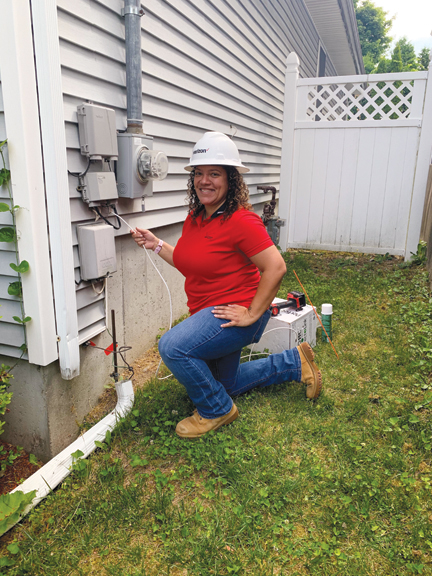
|
|
Cranston, R.I., Local 2323 member Jo-Ann LaRose has been a splice-service technician for Verizon for 21 years.
|
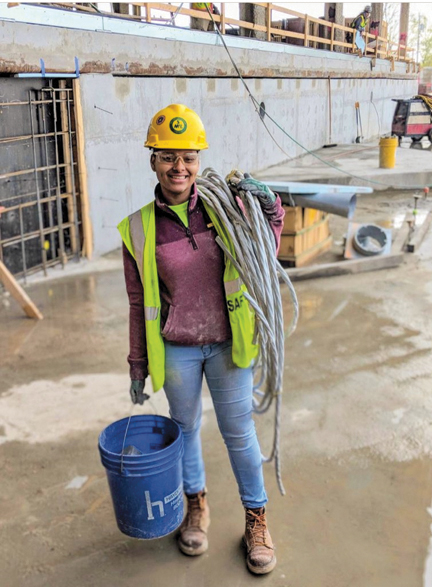
|
|
Boston Local 103 member Cleide Gomes is a third-year apprentice learning and working her way to the middle class.
|
It’s a powerful statement of the values that IBEW leaders and members pledge to uphold when they take the oath of membership. And combined with the union’s first objective, to organize all workers in the entire electrical industry in the United States and Canada, the message is unmistakable.
“There is a place in the IBEW for working people of every race and gender, every religion and sexual orientation, every background,” said International President Lonnie R. Stephenson in launching the implementation phase of the union’s new diversity, inclusion and equity initiative, “IBEW Strong.”
“This diversity and full inclusion effort is about making sure that the IBEW genuinely represents the interests of every single worker in our industries,” he said. “It’s about ensuring that people entering the workforce today — members of one of the most diverse generations in history — feel that they have a place in the IBEW.”
There’s nothing new about seeking to represent the voiceless and unrepresented. The IBEW has long stood for solidarity, equality and against oppression of any kind. So, IBEW Strong is a natural outgrowth of what this union has stood for since its beginning, Stephenson said. The IBEW should be a place that welcomes all workers and gives everyone a voice and a shot at a better life for themselves and their families.
“We need to include everyone, regardless of history, background, or job classification,” said Boise, Idaho, Local 291 Business Manager Mark Zaleski, who served on the Diversity and Inclusion Committee. “Society is changing, but the thing is, everyone deserves good wages and benefits, and we can offer that. That’s how we stay strong.”
The Diversity and Inclusion Committee grew out of a unanimously passed resolution at the 39th International Convention in 2016. Made up of officers and other IBEW leaders and members from every branch, district and background, its members have worked behind the scenes for the last three years. Through the work of the committee and discussions with the international vice presidents and executive officers, members of the Electrical Workers Minority Caucus, RENEW/NextGen and the Women’s Committee, five themes were identified as part of a strategic plan to strengthen and grow the IBEW. They are:
Organizing/Expanding Membership: Develop and expand outreach, recruitment and marketing programs to young people, nontraditional and historically marginalized communities.
Education and Training: Provide training and education programs that address the importance and need for inclusion to all IBEW members and leaders.
Building Member Capacity: Provide inclusive opportunities for members to learn and develop leadership skills and foster local union activism.
Leadership Advancement: Provide opportunities for all local union members to take on leadership roles.
Replicating Best Practices: Document, share, and replicate best practices for creating a stronger IBEW through outreach and inclusion programs.
Now, the focus shifts to putting the ideas behind these themes into practice.
With input from the committee, the Education Department is working on a variety of trainings for locals, as well as outreach efforts, including to schools, and a collection of best practices that will be shared union-wide. The trainings will vary in length, content and audience, including some geared toward leadership, and eventually include a train-the-trainer version.
“We want locals to see the value of diversity and inclusion,” said Education Department Director Amanda Pacheco. “The IBEW will be stronger for this, and we can lead the way.”
Learning from Experience
In locals across the U.S. and Canada, the principles and ideals of the initiative have already been in action, in some places for a decade or more. And many of those successful programs helped to form the backbone of the new international effort.
From Vancouver, British Columbia, Local 213’s outreach to aboriginal youth, to Boston Local 103’s recent campaign to bring in more women and people of color, great strides are being made.
The Indiana Plan is a grassroots organization that recruits potential apprentices from areas that have been traditionally underrepresented in the trades. The Plan, which is exclusively union, works with area trades, including Indianapolis, Ind., Local 481. It also recruits from inner city schools, churches and community organizations. Its executive director, Devon Doss, is a 21-year IBEW member and a product of the program.
“Not only do we look like the individuals that we are recruiting, our stories are similar to theirs,” Doss said. “In turn, I believe they can see themselves in us, and one day in the IBEW.”
“Over the years, the Plan has connected us with a lot of members from minority communities who are now active members of RENEW, the executive board and performing valuable service elsewhere in the union,” said Sixth District Vice President David J. Ruhmkorff, a member and former business manager of Local 481. “That speaks highly of the program, but it’s also grown our union and been hugely important in bringing a diversity of perspectives that have made us better.”
Doss is also deeply committed to the idea that diversity isn’t just good for meeting federal requirements for government contracts.
“Diversity gives the trades a vast amount of creative thinkers that come from all walks of life,” he said. “This can only enhance the trade.”
In upstate New York, the Multi-craft Apprenticeship Preparation Program works with the Rochester Building Trades to help the area’s underserved communities. The idea behind the program is to expose participants to all the local building trades to see which one they have the most interest in, says Rochester Local 86 Business Manager Michael Bader. As with many pre-apprenticeships, participants are taught the basics in safety, math, first aid and CPR and how to use power tools. They visit all the local training centers and learn the specifics of the application process and minimum requirements for each trade.
“While we have a lot more work to do to help the disadvantaged communities, this is a step in the right direction,” Bader said. “It shows that the IBEW is stepping up to be part of the solution.”
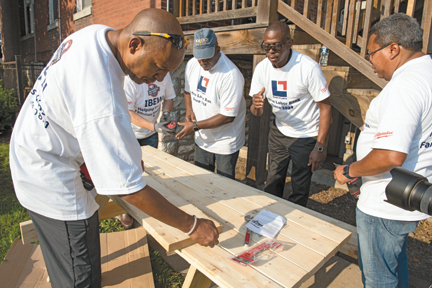
|
|
The International Convention adopted the Electrical Workers Minority Caucus' longtime practice of hosting a "Day of Service" with its events in 2016.
|
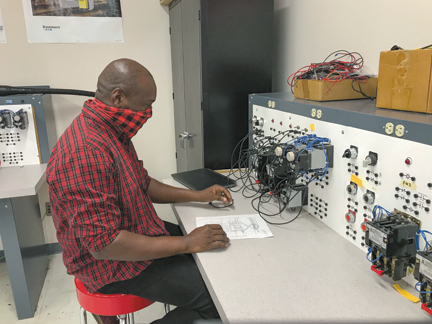
|
|
Fourth-year apprentice Javier Harvey practices COVID-19 safety while being tested on motor control wiring at Orlando's Central Florida JATC.
|
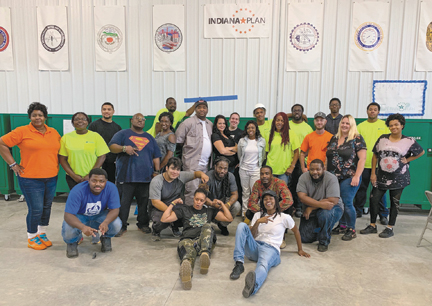
|
|
Students from the Indiana Plan's September 2019 graduating class, above, completed their training and many have already been accepted into apprenticeships.
|
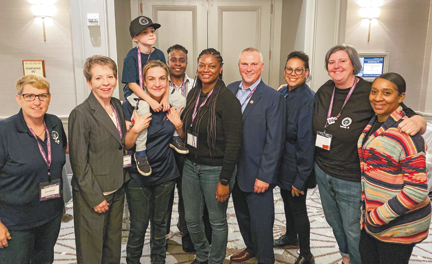
|
|
IBEW delegates attend the 2019 Tradeswomen Build Nations conference.
|
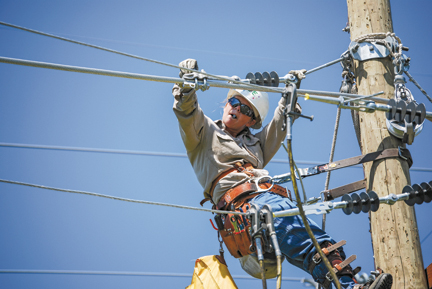
|
|
A Louisville, Ky., Local 2100 lineworker at LG&E practices safety and proper technique during a training session.
|
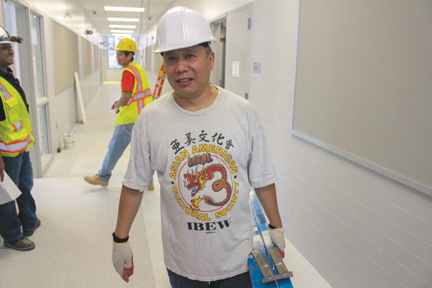
|
|
Journeyman wireman John Zhao, a member of Local 3's Asian-American Cultural Society, at work in the Bronx.
|
Kereem Berry, a Local 86 journeyman wireman and executive director of MAPP, says there was a study done a few years back that found that Rochester was the second-worst place economically for African Americans in the U.S.
“Being an African American man who’s gone through the apprenticeship to become a journeyman wireman, I understand the challenges other African Americans will face while navigating their journey of apprenticeship,” Berry said. “Further, sitting at the Rochester Building Trades Council, we are able to be the voice of the inner city and advocate for the equality the unions tout for the residents where the work is actually taking place.”
Similar programs can be found across North America. Toronto Local 353 works with the Hammer Heads program, created in 2009 by the Central Ontario Building Trades to work with at-risk youth and get them into apprenticeships.
“Before the program, most of our participants were living in community housing and the shelter system and were recipients of social assistance,” Central Ontario Building Trades Business Manager and Director of the Hammer Heads program James St. John said. “Since graduating, [they] have entered into registered apprenticeships within the skilled construction trades and become contributing members of their communities.”
Recruiting the Future
Boston Local 103 announced this June that it had increased its number of women apprentices by 34%. Business Manager Lou Antonellis says they did it by putting in charge Business Agent Kenell Broomstein, the first women of color to serve as a business representative in the Boston building trades.
“We made this happen by staying true to what we believe and working hard to achieve it. We made a commitment to do better,” Antonellis said.
His local has also run recruitment ads specifically seeking to bring more young people of color from the city of Boston into the local’s apprenticeship program and made huge strides in the area.
Detroit Local 58 has had similar success. Like Local 103, they made a concerted effort to reach out to potential members in their city, which is majority African American. Mike Richard, former Local 58 business manager and current director of the IBEW’s Construction Department, says that a hurdle for them was the lack of math being taught in the public schools. So, they hired a tutor and got Local 58 member Felicia Wiseman to teach their first-year curriculum at the A. Philip Randolph Career and Technical Center. They also amended their standards to allow direct interview or entry for anyone who successfully completed the program at Randolph. Their numbers went from a 4% success rate of Detroit residents getting into the program to almost 18% getting accepted in the first year.
Another issue they had was with getting women into the trades.
“Most people do not see the trades as a viable career choice for young women. Obviously, we disagree,” Richard said.
Local 58 embarked on a multi-year media campaign featuring IBEW women. They created commercials highlighting sisters who told their stories about becoming an electrician in the IBEW and about the great wages and benefits that come with it. Now, the local’s women’s committee is one of their most active and engaged groups. With the enthusiastic support of Business Manager Brian Richard, the committee even opens its meetings to those interested but not yet a part of the union, and it is working with other trades on best practices for recruiting and retaining women.
Nearby, Detroit Local 17, which represents utility workers and tree trimmers, has been successfully working with utility DTE and formerly incarcerated individuals and soon-to-be released inmates to train them to work in the notoriously difficult and dangerous field of line clearance.
“I’ve learned from my peers — both in Michigan and in other states — that returning citizens who are looking for a second chance in life can be among your very best and most loyal employees. They just need to be given a chance,” said Gerry Anderson, DTE’s chairman.
In Colorado, Denver Local 111 is working with an area halfway house to educate returning citizens about what the trades can offer someone after they complete their prison sentence.
“One guy told me how when he got out, he was given $20 and a bus ticket. He wasn’t sure what to do,” said Business Manager Rich Meisinger. “Then he found the IBEW, and now he has a career.”
Local 111 members are also going into schools to teach students about the opportunities available. The local represents roughly 4,250 members in areas including utility, communications and inside and outside construction.
“Kids get to see how a bucket truck works, how an excavator operates, all kinds of things,” Meisinger said. “It’s a great way to show young adults all that is offered through the union, not to mention the wages and benefits.”
In Oregon, Portland Local 48 moved to recruit and retain more women earlier this year, working with the National Electrical Contractors Association to add a new maternity leave benefit for its members, as well as those of three other locals in the state. The benefit allows for six months of paid leave, with 13 weeks being available prior to the expected due date and 13 more available after.
“This leave policy will enable more women to join and remain in our industry, which is a huge benefit to contractors who rely on women to help them build their workforce,” said Bridget Quinn, workforce development coordinator for the NECA‐IBEW Electrical Training Center.
And when Local 291 successfully organized a group of DirecTV workers, it wasn’t just new members; it was also a new classification for them. The local represents mostly construction, so the telecom drive was new territory. But what helped them win was their commitment to inclusion. Another union was also competing for the workers, but they chose the IBEW, in part because of its commitment to organizing all workers, regardless of things like gender identity or sexual orientation.
“We opened our arms to this group of people that weren’t being recognized by the other union, and it made a huge difference,” Zaleski said. “It really opened my eyes to how we can grow.”
Local 291 was also the first IBEW local to organize political workers in the state’s Democratic party.
Education and a New Generation of Leadership
IBEW Strong will be integrated into organizing efforts and other programs like the Code of Excellence. In fact, the Code has gotten some attention recently from the AFL-CIO. President Richard Trumka invoked the Code as a means of addressing issues like racism by way of accountability.
“The Code is about doing your job well, but it’s also about so much more than that,” Stephenson said. “You are your brother’s and your sister’s keeper. Don’t ignore injustice when you see it.”
Stephenson recalled an organizing drive in Milwaukee years back where the IBEW was trying to reach a group of manufacturing workers who spoke mostly Spanish. Unfortunately, the organizers only spoke English.
| IBEW Diversity &
Inclusion Committee
|
|
Vision Statement:
|
“When we did our door knocking, we sent white males. We lost the campaign,” Stephenson said. “We need to have organizers who understand the community we want to organize.”
Of course, in order to be truly inclusive, an organization needs to do more than just say the words. It’s going to take a long time and will very likely involve some tough conversations.
“It’s not about you, really, it’s about the IBEW,” said Nashville, Tenn., Local 429 President Kim Sansom, who also served on the committee. “People don’t like change, but change is what we need if we want to be a better and stronger and a more diverse and inclusive IBEW. We can’t have growth without change.”
That concept of growth through inclusion is tied closely with the union notion of solidarity. When New York Local 3 member Erin Sullivan teaches her trade unionism class, she leads participants through an exercise where one person is asked to lift a table, to no avail. Then she gets the class to help and the task becomes manageable, something they can easily do — together.
“That’s how solidarity works,” Sullivan said. “We are and always will be stronger together.”
Sullivan, who directs Local 3’s mentorship program and serves as the Third District representative for the International Women’s Committee, noted the importance of education and personal connection in creating a more truly inclusive IBEW.
“I think education and conversation are key. We cannot simply make people comply with the ideology of diversity and inclusion,” Sullivan said. “When members share their stories with one another they will want to see change, because now it’s personal. They can now see how a lack of inclusiveness has affected someone they know.”
Sansom also noted the role of education.
“It comes down to the local. That’s where we need to educate,” said the inside wireman. “And it should be top-down, bottom-up, meet-in-the-middle education.”
The final piece of the puzzle, Stephenson said, is to diversify the leadership within the IBEW so that, with time, IBEW leadership looks more like the members it represents.
“It’s not enough for us to recruit members from all communities and walks of life if we don’t provide those members the same opportunities to advance, grow and lead,” he said. “When the leadership is all white men, others don’t feel as connected or represented. That starts at the local level, but we want to see more women and people of color at the district level, in the kind of roles that can lead to vice presidents and more. I’m in my job because I got opportunities along the way. Every member deserves that opportunity.”
Growing that base of leaders is an important component of IBEW Strong, which will work to encourage people of all backgrounds to run for office and assume leadership roles in their locals and elsewhere. Countless studies have shown the importance of having someone who looks like you in a leadership role. It helps to expand the boundaries of what is possible for someone and makes it easier for them to see themselves as a potential leader.
None of this will happen overnight, Stephenson said, but the concentrated effort starts now.
“Given all that’s happening in North America and around the world, the timing of our work could not be more important. It’s up to every single one of us to make sure that the IBEW not only survives, but thrives, long after we’re gone. Being inclusive, expanding the borders of opportunity to everyone in our communities, is the way we make sure that happens. It’s not just the right thing to do. It’s the smart thing to do so this great union lasts another 129 years.”
Is your local leading the way in diversity and inclusion? Let us know and we may highlight your work in a future story. Contact us at media@ibew.org.